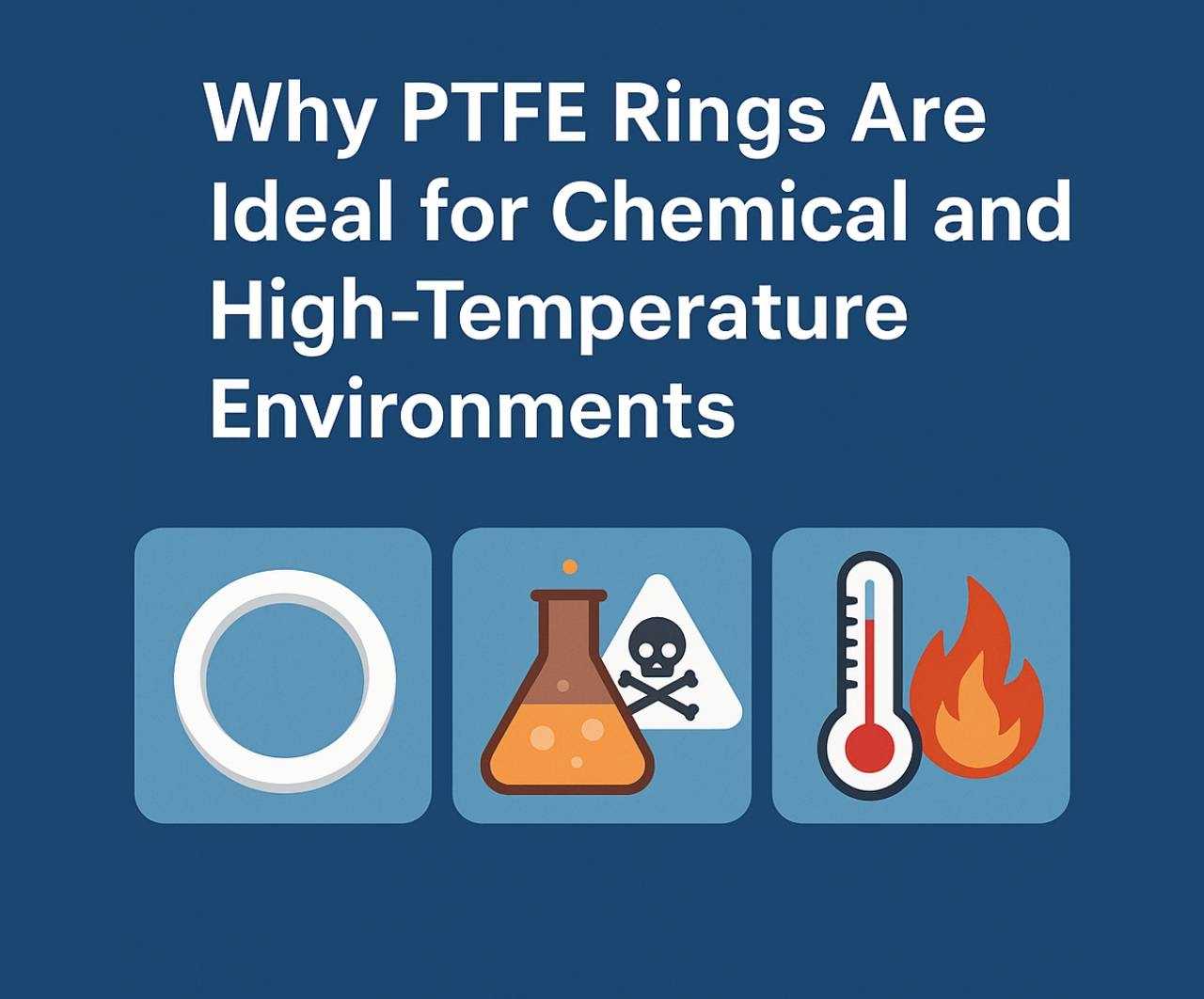In demanding industrial applications, seal materials face relentless punishment from aggressive chemicals, high pressures, and extreme heat. This is where PTFE encapsulated o rings, PTFE coated o rings, and PTFE encapsulated Viton o ring products prove their value. Known for their extraordinary chemical resistance, thermal stability, and low-friction properties, these PTFE-based sealing solutions have become indispensable in process industries like petrochemical, pharmaceutical, food production, and aerospace.
In this guide, we’ll unpack why PTFE rings outperform conventional elastomers in harsh environments, the unique advantages of each variant, and fresh ideas for applying them in modern, efficiency-driven systems. Know more..
What is PTFE?
PTFE (polytetrafluoroethylene) is a high-performance fluoropolymer recognized for its non-stick surface, low coefficient of friction, and outstanding chemical resistance. Best known by the brand name Teflon®, PTFE offers exceptional stability in extreme temperatures and under attack from aggressive chemicals.
This makes PTFE the ideal material for encapsulating and coating o-rings, creating high-integrity seals for environments where standard rubber would quickly fail.
Key Advantages of PTFE Encapsulated and Coated Rings
PTFE encapsulated o rings and PTFE coated o rings provide several operational benefits:
- Unmatched chemical resistance: Compatible with acids, solvents, hydrocarbons, and caustics.
- Temperature resilience: Operating ranges from -60°C to +260°C.
- Low-friction performance: Minimizes heat buildup in dynamic applications.
- Non-stick surface: Prevents adhesion to mating surfaces.
- Food and pharmaceutical compliance: FDA and USP Class VI compliant options available.
When conditions exceed the limits of conventional materials, PTFE sealing solutions reliably step up.
PTFE Encapsulated O Rings: Sealing Confidence in Aggressive Applications
PTFE encapsulated o rings feature an elastomeric core (typically silicone or Viton®) encased in a seamless PTFE jacket. This structure combines the flexibility and compression set resistance of elastomers with the chemical and thermal properties of PTFE.
Ideal for:
- Chemical processing valves and pumps
- Pharmaceutical sterilization equipment
- Aerospace fuel and hydraulic systems
Advantages:
- Handles aggressive media while retaining core elasticity.
- Offers wide temperature performance.
- Prevents chemical attack on elastomeric materials.
Pro Tip: Select PTFE encapsulated Viton o ring options for improved resistance to oils, fuels, and aromatic hydrocarbons.
PTFE Coated O Rings: Low-Friction, Clean-Sealing Performance
PTFE coated o rings differ in that the PTFE forms a bonded outer skin over a standard elastomer o-ring, rather than a full encapsulation. This creates a low-friction, chemically resistant surface while retaining the full elasticity of the elastomer core.
Ideal for:
- Pneumatic cylinders
- High-purity water systems
- Semi-conductor processing equipment
Advantages:
- Reduces installation damage from twisting or abrasion.
- Minimizes breakout friction in dynamic sealing.
- Resists chemical swelling, sticking, and degradation.
Pro Tip: When installation ease is critical—like fitting into narrow gland grooves—PTFE coated o rings are a smart upgrade.
Comparing PTFE Encapsulated Viton O Ring to Other Options
PTFE encapsulated Viton o ring components combine a Viton® core with a PTFE outer jacket. This pairing excels in applications involving fuels, oils, acids, and high temperatures.
| Property | PTFE Encapsulated Viton O Ring | PTFE Encapsulated Silicone | Standard FKM O Ring |
| Max Temperature | +260°C | +260°C | +200°C |
| Chemical Resistance | Excellent | Excellent | Good |
| Compression Set | Good | Excellent | Excellent |
| Elasticity | Moderate | Excellent | Excellent |
| Oil/Fuel Resistance | Excellent | Moderate | Excellent |
Best Use: Aggressive chemical environments where oil and fuel exposure coincides with high-temperature cycling.
New Ideas: Hybrid PTFE Seals for Multi-Function Systems
Recent innovations blend PTFE with other high-performance materials for added functionality:
- Graphite-filled PTFE: Improves thermal conductivity and wear resistance in dynamic seals.
- Carbon-filled PTFE: Reduces frictional heat in high-speed rotary applications.
- PTFE encapsulated FEP o-rings: Balance flexibility with ultra-high chemical resistance for biotech and chemical process industries.
These hybrids extend the functional envelope of PTFE encapsulated o rings and PTFE coated o rings into new territory.
Sustainability and Compliance Benefits
PTFE materials also support cleaner, safer operations:
- Low permeability: Reduces emissions of volatile organic compounds (VOCs).
- Longer service life: Decreases waste from frequent seal changes.
- Food-grade and medical approvals: Simplify regulatory compliance in sensitive industries.
Replacing multiple elastomer materials with a single PTFE encapsulated Viton o ring standardizes inventory and simplifies maintenance programs.
Best Practices for Specifying PTFE Rings
To optimize performance:
- Match core materials to system pressure and temperature. Use Viton® cores for oil-heavy applications.
- Verify chemical compatibility charts for process fluids.
- Allow for thermal expansion of PTFE during assembly.
- Use proper gland design tolerances to accommodate PTFE’s lower elasticity.
- Consider FDA-grade PTFE for food and pharmaceutical use.
- Schedule regular visual inspections to detect surface cracking or deformation under prolonged stress.
Common Industries Benefiting from PTFE Rings
PTFE encapsulated o rings, PTFE coated o rings, and PTFE encapsulated Viton o ring products serve critical roles in:
- Petrochemical refineries
- Chemical processing plants
- Pharmaceutical manufacturing
- Aerospace hydraulic systems
- Semiconductor fabrication
- Food processing equipment
- Desalination and water treatment plants
Where failure isn’t an option, these sealing solutions offer peace of mind.
The Role of PTFE in Cleanroom and Semiconductor Applications
In cleanroom environments, contamination control is vital. PTFE encapsulated o rings prevent chemical leaching and outgassing that can compromise semiconductor production. Their ability to maintain seal integrity in vacuum chambers and plasma etching systems makes them indispensable in high-tech industries.
Similarly, in medical device manufacturing, PTFE’s non-stick, biocompatible properties help maintain sterile process conditions.
Customizing PTFE Seal Designs for Specialized Applications
Modern sealing technology enables the customization of PTFE encapsulated o rings and PTFE coated o rings for highly specific environments:
- Dual durometer cores: Combine soft silicone for flexibility with harder FKM for chemical resistance.
- Profiled PTFE jackets: Reduce friction while maintaining pressure resilience.
- Special color coding: Simplifies compliance audits and material identification in multi-material systems.
Custom-engineered seals maximize system uptime and extend component life in demanding chemical and thermal cycles.
Final Thoughts
PTFE-based sealing products have revolutionized industrial sealing for chemically aggressive and high-temperature environments. Whether you need the flexibility of an elastomer with the chemical shielding of PTFE, or the low-friction installation benefits of a coating, PTFE encapsulated o rings, PTFE coated o rings, and PTFE encapsulated Viton o ring assemblies are purpose-built for these challenges.
With new hybrid materials emerging and sustainability considerations increasingly driving operational choices, now is the perfect time to audit your sealing solutions and explore how PTFE rings can extend equipment life, improve safety, and enhance process reliability.
Choosing smarter seals starts with choosing the right material—and for tough, high-demand applications, PTFE remains the gold standard. Know more..


